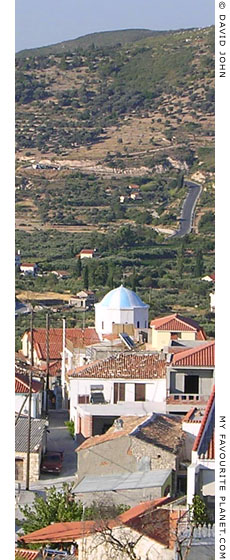The inland village, or small town, of Chora (Χώρα) [1] lies at the foot of a southeastern spur of the Ambelos mountain range (see gallery page 34), on the junction of roads southeast to Pythagorio (3.4 km), west to Pyrgos (11 km), and northwest to Mytilinii (2.5 km) and Vathy (8 km).
It is a pleasant, though unremarkable place with shops, restaurants and bars, and an excellent open-air cinema. Since it is a busy traffic hub for the island, the main streets can get very noisy in Summer. More interesting are the old houses and churches in the narrow side streets, and the views from the hills around.
The name Chora means village, and on many Greek islands (for example Patmos and Samothraki) denotes the main settlement, usually built inland as protection against of attacks by pirates and other enemies from the sea. Chora can not be seen from the sea, although you can get a glimpse of the coast from the hills above (see gallery page 37).
Pirate attacks and political insecurity forced Samians to abandon coastal settlements from around 1475, and those who remained on the island moved inland. It took over a century for the island to be gradually repopulated, and by the 17th century it was reported that Chora was the largest of the island's remaining 16-20 villages, and was referred to as "Megali Chora" (Μεγάλη Χώρα‚ large village). Its location was far enough from the coast to afford protection but close enough to access the harbour at Tigani (Pythagorio). It was also at the centre of routes to the north and west of the island.
Chora became the residence of Turkish administrators of Samos and an archbishop, but by the beginning of the 18th century, following the attack on the island by the Venetian general Francesco Morosini, the Chora and many of the other villages were abandoned. The Ottoman Turks later repopulated the island by resettling people from other places such as Chios, Lesbos, the Peloponnese, Crete, Karpathos and Ikaria.
During Samos' brief period of independence 1821-1834 (the Greek War of Independence, see gallery page 13), Chora lost its importance to the new provisional capital at the port of Lower Vathy. In 1834 the Ottoman Turks regained control of Samos and appointed princes to govern the island as the semi-autonomous Principality of Samos (Ηγεμονία της Σάμου). During the rule of Prince Alexandros Kallimachis (ruled through his delegate Georgios Konemenos 1850–1854 [2]) Chora became the capital in 1850, and it remained the main settlement until 1854 when his successor Ion Ghikas (Ιωάννης Γκίκας, 1816-1897, ruled 1854-1859) moved his residence and administration to the port of Lower Vathy.
Tigani-born Prince Miltiadis Aristarchis (Μιλτιάδης Αριστάρχης, 1809-1893, governed Samos 1859-1866), redeveloped his home town with the aim of making it the capital. However, he became unpopular and was deposed before he could realise this ambition. Vathy, with its larger and deeper harbour, had meanwhile become more important politically, socially and commercially than either Chora or Tigani, and remains so today. |
|

Another typically Samian blue
and white striped church dome. |